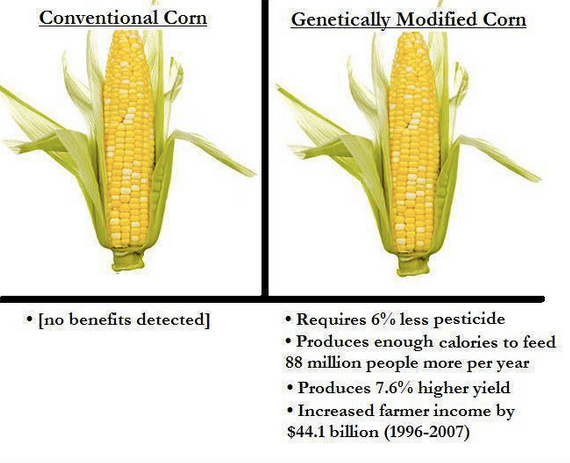 The acronym “GMO” is consistently thrown around when you
talk about modern agriculture, but genetically modified organisms are probably one of the most misunderstood aspects of agriculture. The communication gap
between producer and consumer is larger than it has ever been before, around
only 2% of the U.S. population is directly involved in agriculture. Meaning
that 98% of the population is uninvolved with the production of their food and
all that it entails and thus education and awareness must be raised. Genetic modification
within organisms, food production systems and crops has been occurring for 20+
years. GMOs are organisms in which an addition of favorable traits/genetic
material is planted within the organism’s make-up in order to produce a more
superior product.
The acronym “GMO” is consistently thrown around when you
talk about modern agriculture, but genetically modified organisms are probably one of the most misunderstood aspects of agriculture. The communication gap
between producer and consumer is larger than it has ever been before, around
only 2% of the U.S. population is directly involved in agriculture. Meaning
that 98% of the population is uninvolved with the production of their food and
all that it entails and thus education and awareness must be raised. Genetic modification
within organisms, food production systems and crops has been occurring for 20+
years. GMOs are organisms in which an addition of favorable traits/genetic
material is planted within the organism’s make-up in order to produce a more
superior product. The benefits of genetically modified products are quite numerous. GMO ingredients are designed to allow producers to do more with less and thus increase their efficiencies and while decreasing input costs. GMO products reduce the usage of pesticides because they are deliberately set with insecticide within their genetic make-up, reducing the need to spray herbicides on the field themselves and thus preventing added deterioration of the land. Other benefits of GMOs include drought resistance, allowing for less water usage, decreased weeds, and increased crop yields. Collectively, all these benefits of genetically modified organisms add up to the fact that we are able to feed more people with the same amount of land due to increased yields and efficiencies.
 If there was more time spent trying to understand
the mechanics behind the agricultural system I think a lot less people will
have a problem with the so called system. In effort to keep up with the ever-changing
world we live in, agricultural producers have had to adjust. One of their
adjustments has been to better the crop strains and the way in which things are
done. The use of GMOs is no different than that of using a tractor instead of a
horse-drawn plow, an ordinary upgrade to the more efficient model. The safety
of GMO products has been tested time and time again and has revealed no
scientific basis in which should indicate the consumer shouldn’t trust these
products. The use of GMOs in developing countries has been more of a necessity
rather than a luxury. The use of said ingredients has allowed for developing
countries to feed more people in rural areas where water is scarce and
resources are not plentiful. With so many benefits, and a lack of scientific
backing to prove harms the question of GMO versus non GMO seems immaterial. Producers
don’t wish to provoke distrust from consumers, they only attempt to better the
production process and system, not destroy it, which has become a hard thing to
portray to the consumers at large. As an entity, agricultural sets out to feed
the population, not to cause harm, illness, or anything of the sort, so trust
in the process and investigate the practices to educate yourself
on the who, what, where, when, why, and how of where your food comes from.
If there was more time spent trying to understand
the mechanics behind the agricultural system I think a lot less people will
have a problem with the so called system. In effort to keep up with the ever-changing
world we live in, agricultural producers have had to adjust. One of their
adjustments has been to better the crop strains and the way in which things are
done. The use of GMOs is no different than that of using a tractor instead of a
horse-drawn plow, an ordinary upgrade to the more efficient model. The safety
of GMO products has been tested time and time again and has revealed no
scientific basis in which should indicate the consumer shouldn’t trust these
products. The use of GMOs in developing countries has been more of a necessity
rather than a luxury. The use of said ingredients has allowed for developing
countries to feed more people in rural areas where water is scarce and
resources are not plentiful. With so many benefits, and a lack of scientific
backing to prove harms the question of GMO versus non GMO seems immaterial. Producers
don’t wish to provoke distrust from consumers, they only attempt to better the
production process and system, not destroy it, which has become a hard thing to
portray to the consumers at large. As an entity, agricultural sets out to feed
the population, not to cause harm, illness, or anything of the sort, so trust
in the process and investigate the practices to educate yourself
on the who, what, where, when, why, and how of where your food comes from.Sources:
https://factsaboutgmos.org
No comments:
Post a Comment